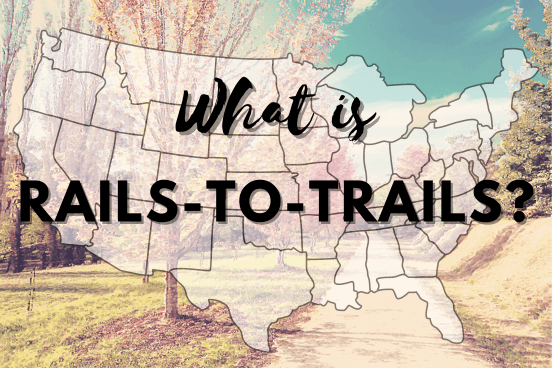
This blog addresses what is meant by the phrase, “rails-to-trails.” Our law firm is the only firm in the country that exclusively represents landowners in rails-to-trails litigation, and we have represented more landowners and collected more money ($390 Million and counting) in rails-to-trails cases than any other firm.
The History of Rails-to-Trails
In the early 1900s, the federal government imposed several regulations on the railroad industry in an effort to control what the government considered to be a “public utility.”[1] One of the regulations placed on railroad companies required that, if they desired to abandon any part of their railroad corridors, they had to seek permission from the federal government.
In the 1960s a quiet movement began in some midwestern states. As railroad tracks were removed from abandoned corridors, people began using these open spaces to walk, enjoy nature, and explore the bridges and tunnels left behind. In 1965, the first rails-to-trails conversion took place with the opening of the Elroy-Sparta State Trail in Wisconsin.[2]
In 1980, Congress passed the Staggers Rail Act which deregulated the rail industry. This left railroads to determine which routes to use rather than the government.[3] Following the Staggers Act, 4,000 to 8,000 miles of railroad were abandoned each year throughout the early 1980s.[4]
In response to the high level of railroad lines being abandoned, the federal government passed the Trails Act in 1983. The Trails Act seeks to preserve soon-to-be abandoned railroads by allowing them to be used instead as recreational trails, while at the same time making the corridors available for potential future railroad reactivation.[5] The Trails Act allowed railroad companies to let go of unprofitable routes by donating, selling, or leasing them to public agencies for interim trail use. This process is known as “railbanking.”
In 1995, the Surface Transportation Board (STB) was created by Congress, replacing the Interstate Commerce Commission, to regulate the use of railroad corridors.[6] The STB now governs whether a railroad corridor can be abandoned and/or railbanked for interim trail use.
To learn even more about the history of rails-to-trails litigation, click here.
Current Status of Rails-to-Trails
There are currently more than 24,000 miles of rails-to-trails providing a place for tens of millions of people to walk, run, hike, skate, and cycle each year.[7] Your favorite trail or greenway may have previously been a prior railroad corridor.
Fun Fact: The current longest converted rail trail is 240 miles long and is located outside of St. Louis, Missouri. The Katy Trail was constructed from 1987-1990 on the former corridor of the Missouri-Kansas-Texas Railroad.
There are currently 876 rails-to-trails projects in the works which account for a total of 9,201 miles of trailway.[8]
What is Rails-to-Trails Litigation?
Now that you have an understanding of the history of rails-to-trails and the work being done to convert these abandoned corridors, let’s take a look at how litigation arises out of rails-to-trails conversions. Many people assume that rails-to-trails litigation is a result of people's opposition to a rail-trail, but that’s not the case.
When a railroad abandons a portion of its corridor, the landowners on either side of that corridor are often able to gain possession and control of the land abutting their property that is part of the corridor. However, when the Trails Act is used to cause a rail-trail conversion, that does not happen. Instead, the government authorizes the land to be used for a recreational trail which the landowner did not agree to or authorize. This has long been held as a “taking of land” by the federal government – in other words, eminent domain – and landowners can obtain compensation for the taking of their land.
The Fifth Amendment of the United States Constitution provides, “No person shall… be deprived of life, liberty, or property, without due process of law; nor shall private property be taken for public use, without just compensation.”
That’s where we come in. We represent landowners whose land was taken as part of a rails-to-trails conversion. The litigation of these cases does not mean that the landowners are opposed to the trails being constructed, but simply that they are demanding that the federal government compensate them for the land that was rightfully theirs.
About Us
Again, we are the only law firm in the nation that solely dedicates its practice to rails-to-trails litigation. This area of litigation is incredibly nuanced and having a team on your side who thoroughly knows these laws and the process makes all the difference.
We serve clients across the nation, have handled rails-to-trails litigation involving land in 29 different states, and have obtained over $390 million dollars in compensation for landowners. We are committed to putting our clients first, doing an A+ job on each case, and communicating regularly with our clients as their case proceeds.
If believe you have a rails-to-trails case, contact our law firm at (314) 720-0220 or (816) 303-1500.
[1] https://railfan.com/a-brief-history-of-railroad-regulation-and-deregulation/
[2] https://www.railstotrails.org/about/history/history-of-rail-trails/
[3] https://www.aar.org/article/freight-railroads-the-staggers-act-of-1980/
[4] https://www.railstotrails.org/about/history/history-of-rail-trails/
[5] https://www.railstotrails.org/policy/basics/
[6] https://crsreports.congress.gov/product/pdf/R/R47013
[7] https://www.railstotrails.org/about/history/history-of-rail-trails/
[8] https://www.railstotrails.org/our-work/research-and-information/national-and-state-trail-stats/

